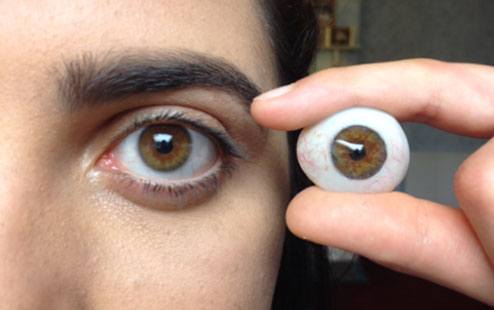A prosthetic eye is an artificial eye which is implanted in patients to restore the volume and near normal appearance of a missing eye. The loss or disfigurement of an eye can be both physically and emotionally painful. A life like prosthetic eye or artificial eye or shell can help regain self esteem ,confidence and social acceptance in a person with loss of one eye.
One eye may be absent since birth or lost due to injury. Sometimes the eye may be blind but painful or the eye may be shrunken due to disease or injury .This kind of shrunken or painful eye may need removal due to intolerable pain or cosmetic disfigurement. Various treatment procedures like placement of ball implants, use of lining from inside the mouth (mucous membrane grafting), use of fat from buttocks (dermis fat graft) and expanders etc. can be performed to restore the lost volume before fitting a prosthesis.
Children may be born with absence of one eye. This can be psychologically traumatising for the parents. When left alone, the facial growth on the affected side may be hampered. The available empty socket can be expanded and implants can be placed to help stimulate facial growth and give a socially acceptable cosmesis.
Creating a life-like ocular prosthesis is achieved by utilizing advanced fitting techniques, proprietary colour matching systems, and a combination of digital technology and hand painted craftsmanship. Fitting the prosthetic eye begins with an ocularist making an impression mould of the socket. Each prosthetic eye is meticulously handcrafted and customized for each patient for precise colour matching, maximising movement, proper eyelid functioning and natural appearance.
You can wear your prosthetic eye during your everyday activities like taking a shower , playing sports, and swimming. You can also cry while wearing your prosthetic eye. Yes ,that is possible as tears are produced in the eyelids and eye socket.
Who may need a Prosthetic eye?
A prosthetic eye may be needed due to the removal of the eye due to various causes such as:
- Injury
- Tumours
- Painful Blind eye
- End stage glaucoma with loss of vision
- Cosmetically unacceptable shrunken or discoloured blind eye
- Absence of eye since birth
- Infection inside the eye
- Abnormal size of the blind eye
Surgery
The surgical procedure to remove the entire natural eye is called enucleation. The surgical procedure to remove the contents of a natural eye is called evisceration. Both procedures will require implant placement during surgery followed by fitting of a prosthetic eye after 6 weeks. Upon removal of the eye, the muscles are reattached to the orbital implant. The implant will replace the lost volume and deliver movement to the ocular prosthesis. Some patients may need mucous membrane(lining from the mouth) or other grafts to increase the lining of the socket .
If your child has been diagnosed with congenital anophthalmia/absence of eye since birth or congenital microphthalmia/small eye; it is important to restore your child’s appearance, and support normal eye socket development. This may include using progressive expanding conformers to enlarge the eye socket cavity for prosthetic eye retention and /or surgery.
Maintenance of Prosthetic Eye
Maintenance of Prosthetic Eye:
- The prosthesis should be worn continuously even during sleep
- Wash hands before handling the prosthesis
- Wash the prosthesis with clean water
- Do not use antibacterial soaps, alcohol, or any other chemical solvents on the prosthesis. These can cause contamination and irreversible discoloration
- Difficulty in closing the eye completely
- Prosthesis should be cleaned twice a week
- Keeping the surface of your prosthetic eye clean will help reduce socket irritation
- Artificial tears or lubricants to be used over the prosthesis
- Polishing is recommended once a year
- Once you have received your new ocular prosthesis, there are also a few important tips to keep in mind to limit its noticeability. When you are talking to another person, make sure to turn and face them directly. If you are wearing a left prosthetic eye, it is also best to position yourself slightly to the right of the person. The opposite is true for those persons wearing a right prosthetic eye. Because most ocular prostheses move more towards the nose, positioning yourself this way will maximize the prosthetic eye’s tracking ability in conversation.
Getting a prosthetic eye can be life-changing for many people. It builds self-confidence by improving your appearance and gives you relief from pain caused by a damaged ,blind eye.
DRR Eyecare & Oculoplasty Hospital is one of the best eye hospital in Chennai for eye care and Oculoplastic Treatment. DRR Eyecare & Oculoplasty Hospital is the best place for getting a prosthetic eye and to get treated by the best eye doctor in Chennai. Visit DRR Eye care & Oculoplasty Hospital for all your eye and oculoplasty related problems.

